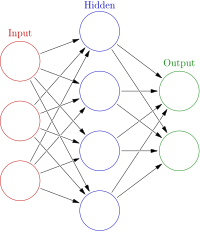
Photo from wikipedia
Dynamic communities in proteins comprise the cohesive structural units that individually exhibit rigid body motions. These can correspond to structural domains, but are usually smaller parts that move with respect… Click to show full abstract
Dynamic communities in proteins comprise the cohesive structural units that individually exhibit rigid body motions. These can correspond to structural domains, but are usually smaller parts that move with respect to one another in a protein’s internal motions, key to its functional dynamics. Previous studies emphasized their importance to understand the nature of ligand-induced allosteric regulation. These studies reported that mutations to key community residues can hinder transmission of allosteric signals among the communities. Usually molecular dynamic (MD) simulations (~ 100 ns or longer) have been used to identify the communities—a demanding task for larger proteins. In the present study, we propose that dynamic communities obtained from MD simulations can also be obtained alternatively with simpler models–the elastic network models (ENMs). To verify this premise, we compare the specific communities obtained from MD and ENMs for 44 proteins. We evaluate the correspondence in communities from the two methods and compute the extent of agreement in the dynamic cross-correlation data used for community detection. Our study reveals a strong correspondence between the communities from MD and ENM and also good agreement for the residue cross-correlations. Importantly, we observe that the dynamic communities from MD can be closely reproduced with ENMs. With ENMs, we also compare the community structures of stable and unstable mutant forms of T4 Lysozyme with its wild-type. We find that communities for unstable mutants show substantially poorer agreement with the wild-type communities than do stable mutants, suggesting such ENM-based community structures can serve as a means to rapidly identify deleterious mutants.
Journal Title: PLoS ONE
Year Published: 2018
Link to full text (if available)
Share on Social Media: Sign Up to like & get
recommendations!